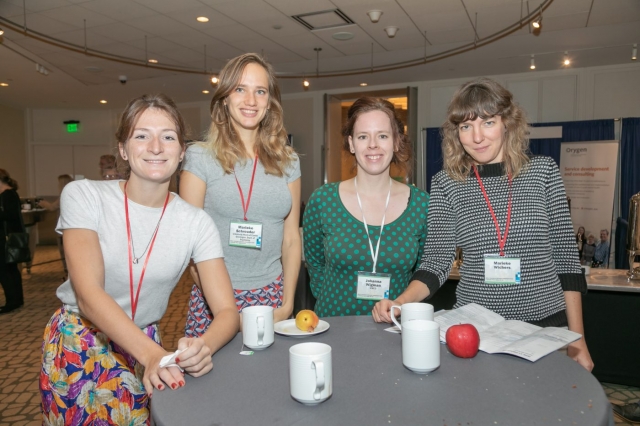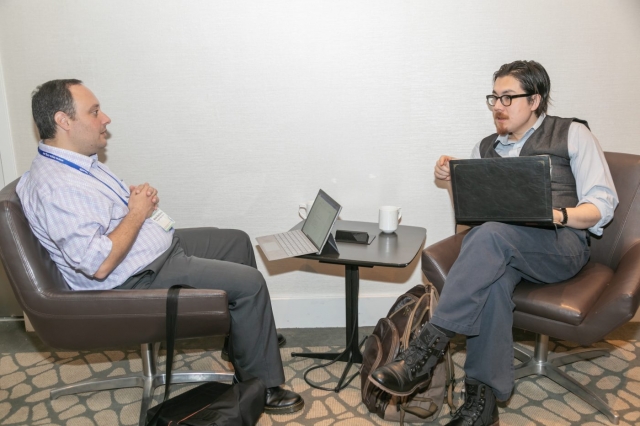October 10, 2018
Posted by:
IEPA
By IEPA.
On the morning of Day 2, we delved deep into the adolescent brain, looking for answers to that familiar early intervention question: why do 75% of mental illnesses begin before the age of 24?
Takao Hensch presented an overview of the critical periods of neuronal plasticity, which occur during various phases of childhood and adolescence, allowing our brains to learn how to hear, see, think, socialise and much more. Research in mice, and even some human studies, are beginning to suggest that rather than being age-dependent and fixed, critical periods are regulated by pathways that can be manipulated to delay, bring forward, or even re-trigger periods of brain plasticity later in life.
That’s good news for those of us well-past adolescence who would like to learn to speak a new language like a native speaker, but given the genes that switch off critical periods also appear to have a neuroprotective effect on mental health, we should probably think twice about interfering.
Takao left us to consider whether plasticity will be the bridge between genes and cognition, something the International Research Center for Neurointelligence is further looking into.
Sarah-Jayne Blakemore then provided some fascinating insights into what goes on in the teenage brain as our social neural networks develop. Although sometimes believed to be a recent, Western invention, adolescence appears to be a unique stage of development across history, cultures, and species – even teenage mice respond to peer pressure to drink alcohol.
Using the example of risk-taking, Sarah-Jayne showed how social context and peer presence affect behaviour during adolescence. Adolescents fear social exclusion, more than any other age group, so they’ll avoid social risk whenever possible. Even if it means engaging in other risky behaviours, such as smoking.
Next, Inez Myin-Germeys presented the many uses of experience sampling methodology (ESM), which asked people to monitor their feelings, symptoms and environment throughout the day. This ‘little data’ approach tries to understand the interactions between psychotic symptoms and a young person’s context, and the process behind the onset of symptoms.
Inez showed how real-time monitoring challenges assumptions about how people experience symptoms. For example, people with anhedonia do react positively to pleasant events – they just might not have so many pleasant events to react to.
With some help from Bob Dylan, whose lyrics seem to relate surprisingly well to findings from contextual psychiatry, Inez made a compelling case for “bringing the person back into the picture.”
The after-lunch sessions covered everything from computer-aided diagnosis to the protective effect of growing up near green spaces.
Symposium 13 speakers discussed the effect of duration of untreated psychosis (DUP) on the efficiency of early intervention treatment.Findings from some well-known trials, including OPUS in Denmark and RA1SE in the US, suggest that the benefits of early intervention services are greatest when provided early, making a case, if one were needed for reducing DUP. Ashok Malla’s research in Montreal showed that a DUP less than 12 weeks leads to better outcomes in an early intervention service, which validates current IEPA and WHO recommendations.
In Symposium 17, we got into the practical aspects of early intervention service delivery, asking ‘what are the essential aspects of early intervention and how do programs ensure they adhere to them?’ Speakers from Canada, Australia, Norway and the US explained how they standardised care in their early intervention services. One view was that we’ve progressed a lot in just the last two years, with a few fidelity scales now available to measure this. But today’s fidelity scales still face challenges of reliability and validity – and a system culture that doesn’t value quality and accountability.
One of the last sessions of the day, Symposium 22, turned the conference theme on its head a little, with some long-term advocates of early intervention debating whether ‘mission creep’ is diluting the efficacy of specialised early intervention services. The hot topic of the session was the recent changes to early intervention services in England, where services now see people up to 65 years old across a range of diagnoses.
‘Broadening the scope’ should mean better care for everyone, but does widening the age and diagnostic eligibility criteria for early intervention services actually deliver better care?
Everyone agreed that early intervention is worthwhile for all mental health conditions, at any age. Katherine Boydell made the case for women with first-episode psychosis, who tend to have an onset after age 25 but still benefit from early intervention.
Even though we need to put adult mental health back on the agenda, it was also agreed that early intervention services can’t be expected to provide care to more people without more resources.
Pat McGorry’s and Katherine’s view was that we should maintain the youth focus of early intervention and create other developmentally appropriate approaches to ensure everyone gets the care they need.
Follow IEPA on Twitter for instant updates from IEPA11.


